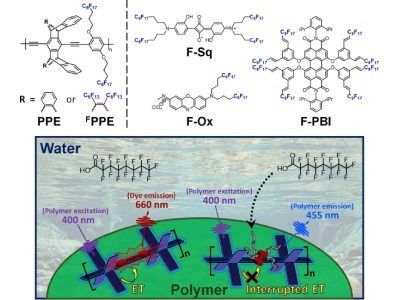
Chemical structure of the fluorous poly(p-phenylene ethynylenes) and fluorous dyes. Conceptual scheme of the mechanism for the detection of PFAS in water: PFOA diffusion from water into the polymer disrupts π–π interactions between the dye and the conjugated polymer, interrupting the electron-exchange-based ET. Credit: Dr. Alberto Concellón et al.
Researchers at MIT have recently developed an economical fluorescence sensor that be used for on-site testing for PFAS in water samples. The sensors provide a cost-effective and portable alternative to traditional testing that involves mass spectrometry.
per- and polyfluoroalkyl substances, or PFAS, are a group of organic compounds that have had their hydrogen atoms replaced with fluorine atoms. They are useful for numerous applications, however, recent research has shown they are toxic to humans and can lead to organ damage or cancer. In the environment, PFAS do not break down and bioaccumulate through plants, animals, or humans. In the EU, limits of 100 ng/l for specific PFAS and 500 ng/l for total of all PFAS were set for drinking water. The US EPA has set much stricter standards of 4nm/l for the most widespread PFAS.
The most common testing method for PFAS requires utilizing mass spectrometry to detect trace levels of PFAS in drinking water. The methods are costly and time-consuming, a problem the researchers from MIT wanted to address. In the research, published in Angewandte Chemie, a fluorescence sensor was developed to detect PFAS in drinking water. The sensor is based on a polymer with fluorinated sidechains containing fluorinated dye molecules within them. The polymer absorbs violet light and transfers that energy to the dye via electron exchange.
Under normal conditions this dye fluoresces red, however, if PFAS are present they enter the polymer and displace the dye molecules effectively switching off the dye's red fluorescence. With the red dye switched off, the blue fluorescence of the polymer is switched on, with the amount of fluorescence proportional to the concentration of PFAS.
The new sensor has a detection limit within the µg/l range for PFOA and PFOS, the most common PFAS, and is suitable for detection in the field.